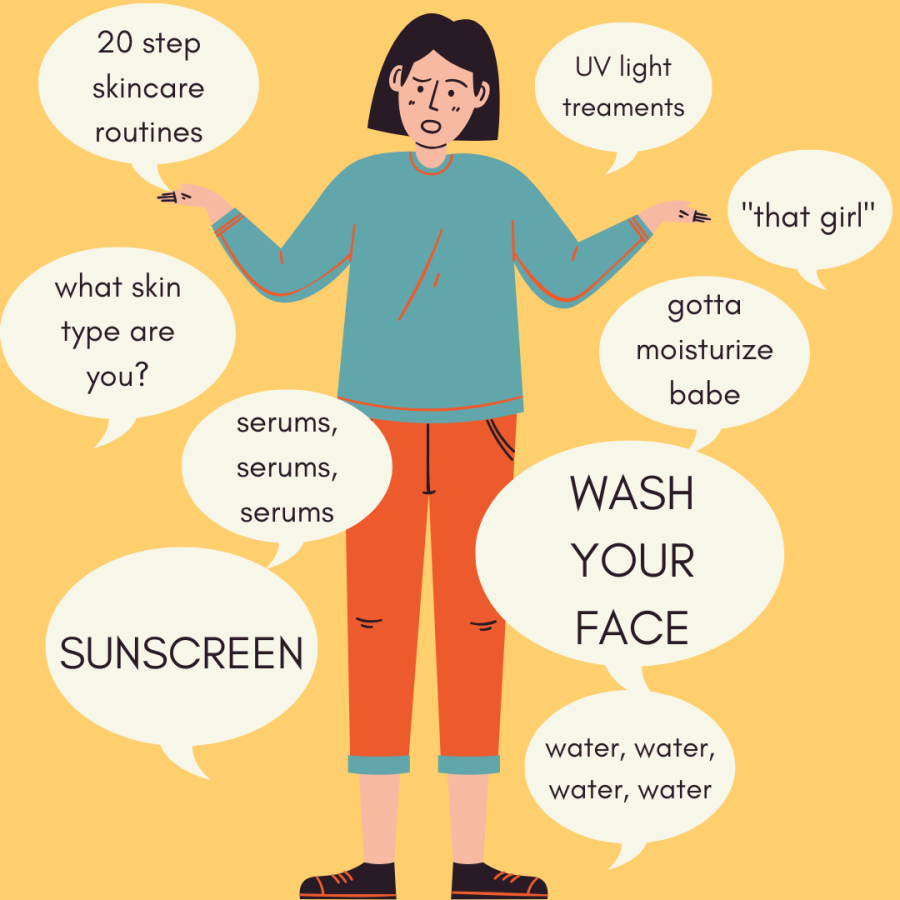Make Your Face Happy
The ultimate guide to building a simple skincare routine
January 9, 2023
Serums. Face masks. Jade rollers. Do’s and don’ts. Wear sunscreen all the time to look 30 when you’re 50! If you’re a member of TikTok, Instagram, or Pinterest, you’re probably familiar with the increasing popularity of skincare routines. But with sponsorships and brand endorsements influencing influencers, how should you decide what to use on that lovely face of yours? (I saw you blush). To start, it is important to establish a skincare routine. It doesn’t have to be twenty steps, in fact, there are only three main steps to taking care of your skin; cleansing, toning, and moisturizing. In this article, we’re going to take a deep dive into how to protect your skin and bring out its full potential.
First: cleansing
Washing your face (gently!) is important for all people, with all types of skin. However, different types of cleansers will work best for specific skin types. The New York Times article titled “How to Build a Skin Care Routine” details these different skin types and pairs them with a cleansing product. If you have oily skin, a water-activated gel or foaming cleanser might be best to clear your pores. However, if your skin is dry and eczema-prone, you might want to lean toward a cleansing cream or lotion. Microcellular water also works for almost all skin types, because it is soap-free and doesn’t need to be rinsed off. Popular cleansers under brand names such as CeraVe or Cetaphil are tried and true products, but might not work for everyone! Another good sign when picking products is the label “non-comedogenic,” which means that shouldn’t clog your pores and therefore shouldn’t trigger acne, however, this isn’t overseen by the Food and Drug Administration (FDA).
Second: toning
Toners don’t have to be acidic and alcohol based, many are not. Toning helps balance your complexion while also adding extra nutrients such as Vitamins E and C or hyaluronic acid to your skin. However, these supplements and serums aren’t as critical to your routine as cleansing and moisturizing (and SPF!). Most dermatologists do consider them “extra,” but toners and serums can be useful to increase hydration retention, reduce redness, or just add another layer of protection to your skin. Serums specifically can be used to spot treat blemishes or dark spots using salicylic and Vitamin C respectively.
Third: moisturizing
Especially in cold, dry Nebraska winters, moisturizing your full body is key. Body lotions and washes with oats, shea butter, and hyaluronic acids without fragrances and retinoids are key to keeping your extremities and torso moisturized, and many people use an even richer moisturizer such as a butter or more solid cream at night.
“Liberal use of moisturizing agents is also helpful. I usually recommend products containing ammonium lactate such as Amlactin. For those with very sensitive skin, products such as Lubriderm or Cetaphil might be a better choice. It is best to avoid any colors or fragrances in skin products. The same goes for any products added to laundry dryers,” says Dr. James Kalar, MD, who is an occupational physician in Council Bluffs, Iowa.
Nicolette Netz, a PA from Lincoln Nebraska, also recommends, “Cetaphil and Cerave for drug store brands. The most hypoallergenic brand for sensitive skin is Vanicream.”
Using humidifiers, keeping your home and shower temperatures from getting too hot (it dries out your skin), and even wearing gloves when washing dishes and using abrasive chemicals are all ways to prevent dryness also. Facial moisturizers should also be used every day. A common misconception about moisturizing is that it causes your face to be oily, but that isn’t the case. However, it is important to identify which type of moisturizer is right for you. A person with oily skin might opt for a water-based, gel moisturizer, while a person with dry skin could use a creamier moisturizer. Another great way to stay hydrated inside and out is to drink water. Water is so so important for your skin and especially in the dry winter months.
Sunscreen could be considered a moisturizer, and it can be found in some, but many also apply SPF as a different step. Sunscreen is probably the most important aspect of skincare because sun damage can happen to anyone and anywhere regardless of skin tone or if you live here or in Florida (I wish). Most experts suggest an SPF of 30 or more, and sunscreen should be applied not only to your face but to your neck and really any other part of your body that is exposed to the sun.
“Excessive sun exposure contributes to premature aging changes in your skin. One must also be compulsive about using sunscreen. Every sunburn episode increases your risk of skin cancer later in life,” says Kalar.
To add, Netz says, “NO amount of tanning beds are safe. Self-tanners are so much easier and better for your skin! Brands that I like are Tan Luxe self-tanner drops, St. Tropez, and Isle of Paradise. . Any form of [sun-produced] tan is still sun damage.” She also recommends using SPF of 30 or higher, with reapplication every two hours, and to steer clear of spray sunscreens because they aren’t as effective and mostly chemical based.
Bonus Tips:
Extra stuff! Once you get those three basic steps down, you can add a little bit of spice to your routine such as:
Face Masks:
Sheet (hydrating), overnight (dry or mature skin treatment), clay/mud (reduce oil/exfoliating), or peel-off (cleansing/pore unclogging) masks are great for focusing on one aspect of your skin that you’ve been struggling with. Exfoliating masks should be used very sparingly, and a mask that makes your skin burn does NOT, in fact, mean that the mask is working.
Pore Treatments:
Mighty Patches by Hero are great for overnight wear to absorb all that icky stuff out of whiteheads instead of popping them, which can cause scarring and oil from your fingers to get underneath your skin. Nose pore patches from brands such as Bioré help release dirt from clogged pores in your nose as well.
Tools:
Products aren’t just chemical formulas. A washcloth (which should be replaced every day!) with 100% cotton content can be especially useful to PAT skin dry before moving on to the rest of your routine after washing your face. Speaking of washing your face, gentle silicone face scrubbers can be a great way to help get your skin squeaky clean but overuse can cause stress on your skin, so be careful. Other tools such as jade rollers and gua shas can be used to depuff and shape your face (some people say). Facial massages using just your fingers can also be beneficial if your goal is to create a more pronounced jawline, although many might not be legit (especially if featured on 5 Minute Crafts).
Note: Not all recommended products or practices might work for your skin, especially if you have a specific skin condition. Consult your doctor or dermatologist before using new products if you have concerns. Not all skincare products work for everyone, but there is one out there with your name on it!










